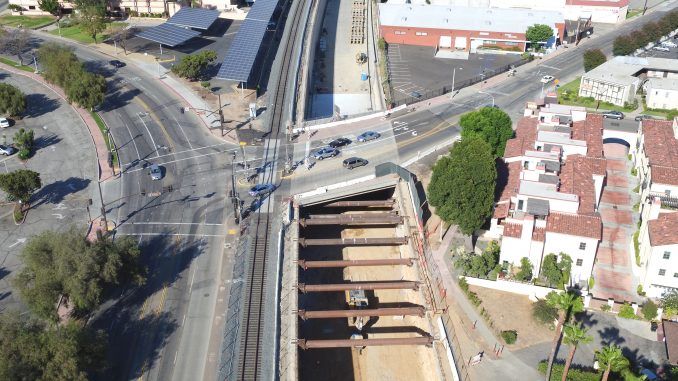
BY ALLISON LEVITSKY
Daily Post Staff Writer
After years of back-and-forth over how to separate the Caltrain tracks from the four Palo Alto streets they intersect, City Council on Tuesday (May 19) will focus in on 10 options for how to take on the multibillion-dollar project.
Once the tracks are electrified in 2022 and high-speed rail launches in 2029, more trains will travel up and down the Peninsula, which will back up traffic at each rail crossing unless the city proceeds with the project.
The 10 options, narrowed down from 34, include three options for the Churchill Avenue crossing, four options for Meadow Drive and Charleston Road and two options for Palo Alto Avenue.
Churchill
At Churchill Avenue, the city may:
• raise the railroad and lower the roadway so the railroad goes over the street
• lower the railroad and raise the roadway so the street goes over the railroad
• block off traffic at Churchill Avenue and do one or more of the following: widen the Embarcadero Road under-crossing, add new traffic signals at the Embarcadero Road ramps, build a bike/pedestrian crossing at Churchill Avenue and/or build a Seale Avenue bike/pedestrian crossing to connect to Peers Park and the Stanford Avenue bike boulevard.
Meadow and Charleston
At Meadow Drive and Charleston Road, the city may:
• raise the roadway and lower the railroad so the street goes over the railroad and build a Loma Verde Avenue bike/pedestrian crossing to connect to the Margarita Avenue bike boulevard
• raise the railroad and lower the roadway so the railroad goes over the street and build a Loma Verde Avenue bike/pedestrian crossing to connect to the Margarita Avenue bike boulevard
• dig a trench or bore a tunnel for the railroad
• build a viaduct for the railroad to travel over the street
Palo Alto Avenue
At Palo Alto Avenue, where Alma Street connects with El Camino near San Francisquito Creek, the city may:
• Close the crossing at Palo Alto Avenue, creating a dead-end. Options include building a bicycle-pedestrian undercrossing below the Caltrain tracks at Everett Avenue and widening University Avenue to handle the traffic now using the El Camino-Palo Alto Avenue-Alma intersection.
• Putting the road under the train at Palo Alto Avenue or putting the train on a viaduct.
Another alternative is that the city could dig a citywide, deep-bore railroad under the roadway tunnel with two new underground rail stations.
The planning, environmental review, design and construction for the project is expected to take the next decade, starting with the narrowing down of the 10 options to between four and eight by the end of next month.
The Rail Committee hopes to finalize the decision by Dec. 13.
An environmental impact report would be completed next year. Project design would start in 2020 and in 2021, the city may acquire dozens of properties that are in the right-of-way of the project.
The construction would start in 2023 and wrap up in 2028.
In November, a consultant hired by the city estimated that grade separations could cost as much as $4 billion if the city dug a cut-and-cover tunnel. Cut-and-cover means they would dig a trench and put earth on top of it.
Lowering Churchill Avenue, Meadow Drive and Charleston Road below Alma Street and the tracks would cost $302 million.
For $221 million, the city could lower Alma Street to meet Churchill, Meadow and Charleston.



Why do I get the feeling we will be talking about these same options 10 years from now? Council will drag this out forever, fearing that any choice would upset some precious constituency. So it will be analysis paralysis forever. That’s become the Palo Alto way.
Menlo Park took a creative approach to this. They decided to just build one bridge at Ravenswood and do nothing at Oak Grove or Glenwood. People haven’t figured it out yet, but one day they’ll realize that the Oak Grove and Glenwood crossings will have to become dead-ends because the feds won’t allow at-grade crossings with high-speed trains. But the MP council figures they can only pay for one bridge, so they’ll just pretend the other two crossings don’t exist. By the time people realize what’s happened, this council will be gone. Classic case of kicking the can down the road, as Bill Clinton used to put it.